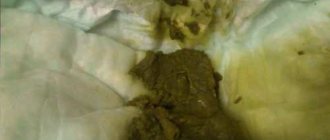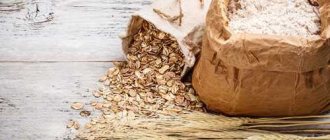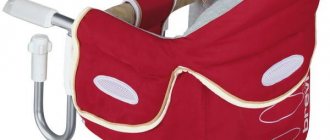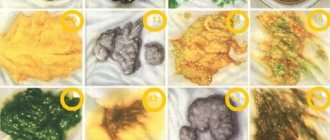What can newborn feces tell you?
In the very first days after birth, the baby’s stool is called “meconium” - sterile feces of a greenish-black hue without the slightest odor.
The original stool ceases to be sterile when bacteria appear in the newborn's intestines, which occurs on the second or third day of his life. From this moment on, the feces change.
Now the ideal bowel movements of a breastfed baby should look like this:
- with a small amount of mucus;
- puree consistency;
- with small lumps of a yellowish or whitish tint;
- stool shade – yellow, greenish or reddish;
- the smell of feces is similar to the smell of slightly sour milk.
Feeding on mother's milk, the baby empties its intestines three to four times a day in fairly large portions. This can happen immediately after the child has eaten.
Some babies can defecate up to twelve times a day, and there are those who only have bowel movements once a week. If the child eats well, then both options are not a deviation from the norm.
When the baby is two or three months old, he defecates no more than five to seven times a day. The consistency of the stool is soft and looks like a slightly liquid porridge.
Types of foamy stools
Normally, babies' bowel movements are mushy and have a yellow tint. In order to determine what foamy stool looks like in a breastfed newborn, it is better to visit a specialist. The pediatrician will more accurately explain what may be causing the disorders, evaluate the smell and consistency of stool, and detect the presence of blood streaks or mucous impurities.
Such symptoms will help the doctor more clearly determine the diagnosis, conduct a high-quality diagnosis and select a treatment method. In most cases, foamy stools are liquefied. If there is not much foam, the stool is mushy, and the symptom appears once a week, this can be considered as normal.
In many cases, studying the color and consistency of the baby’s stool helps to independently carry out the initial diagnosis. Against the background of the appearance of foam in it, the shade changes and a specific smell appears. And such changes are caused by various reasons.
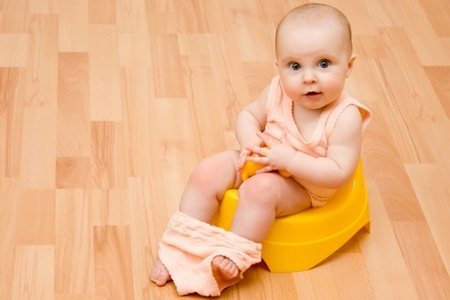
The color of a baby's stool can tell a lot about the baby's health.
Light and liquid
Normally, the color of feces in infants is yellow-brown. The substance stercobilin, which is a pigment, is responsible for color. Also, what shade the stool may be colored depends on the set of foods consumed the day before by the nursing mother. If a woman eats a lot of plant foods and regularly drinks cow's milk, loose, foamy stools in a breastfed baby are not uncommon.
Green
If a breastfed baby has green, foamy stool with a pungent odor, this is a sign of an improper feeding process. In this case, the balance of milk being received by the baby from the anterior and posterior chambers is disrupted. When a baby does not receive enough substances contained in hind or fore milk, disruptions occur in the digestive system, leading to changes in the color and consistency of stool.
The anterior portion contains more water and less fat, so frothy greenish stool in infants is often called “hungry”, because. the baby only manages to quench his thirst, but is not fully satisfied. To eliminate the problem, you should contact a specialist and adjust the feeding process. The baby needs to be latched to the breast for a long time so that he has time to receive not only fore milk, but also hind milk (which contains more fat and nutrients). It is also not recommended to place the baby on one or the other breast during feeding.
Yellow chair
Transient dysbacteriosis is a disease characteristic of infants up to six months and occurs against the background of foamy yellow stool. You can protect your baby from this borderline state by regular breastfeeding - mother's milk contains a lot of immunoglobulins. Thanks to them, the baby’s immunity and intestines become protected.
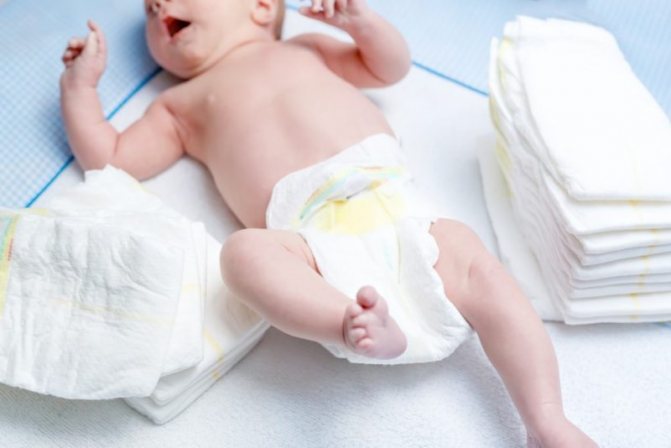
A newborn baby has a sterile intestine, and it begins to be populated with beneficial microorganisms and bacteria as it passes through the birth canal. The digestive system has a hard time adapting, causing the intestines to become stressed and react by producing yellowish, foamy stools. Usually this condition is accompanied by little weight gain and requires a visit to the doctor.
Often the cause of this condition is lactase deficiency, when the baby’s digestive system does not have enough enzymes to break down milk. If a nursing mother consumes a lot of dairy products, the fragile stomach is not able to cope with the load, which is why blood streaks and foam appear in the stool.
Less commonly, congenital dysbiosis is the cause of bloody spots in foamy stools. This pathology is very difficult to treat and the child has to constantly be given medications that maintain the intestinal microflora in a normal state.
The appearance of mucus impurities in foamy stool is often caused by taking inappropriate medications or long-term use of medications. But the symptoms are more likely to indicate the development of an intestinal infection. If, against the background of mucus and foam in the stool, the baby’s temperature has risen, and the condition does not improve within 24 hours, it is better not to delay a visit to the doctor.
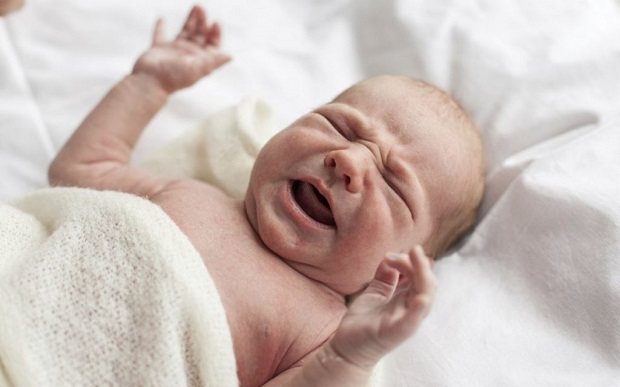
If, along with changes in the color of the baby’s stool, his behavior changes and the temperature rises, then this is a reason to consult a doctor
Possible causes of foamy stools

During the first two months, babies have very frequent bowel movements. After birth, stool is odorless for several days and is characterized by a dark green color. Further, the feces acquire a mushy consistency of orange-brown color, and they develop an odor. This condition is considered normal for breastfed babies.
Since the digestive system of infants is not fully formed, various changes may be observed in the feces. The stool may become watery or foamy and contain blood and mucus. In addition, pieces of undigested food may also be observed in the stool.
Foamy feces that appear in an infant and are temporary in nature are not considered a dangerous condition and do not indicate the development of serious diseases. If changes in feces are observed constantly, then the child should be shown to a doctor.
Most often, foam occurs as a result of fermentation processes in the intestines.
In addition, foamy stool in a baby can be caused by the following reasons:
- allergies;
- staphylococcal or intestinal infection;
- dysbacteriosis;
- lack of enzymes;
- taking medications;
- increased gas formation;
- malnutrition.
The appearance of foamy stool primarily depends on the characteristics of the infant’s digestive system and the type of feeding. In addition, hereditary factors and developmental characteristics of the child influence bowel movements.
Causes of foamy feces in breastfed babies
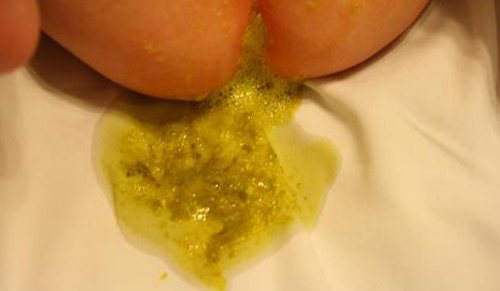
Infants may defecate after skin feeding.
Foamy stool occurs in a breastfed newborn for the following reasons:
- Incorrect maternal diet: abuse of sour fruits, apples, fresh cabbage.
- The mother is undergoing antibiotic therapy or using other medications.
- Early or incorrect introduction of complementary foods.
- Transferring the baby to formula milk for up to six months.
- Allergy to formula or products consumed by the mother.
- In the case when foamy stool replaces constipation, intestinal dysbiosis may develop.
- Malnutrition. In this condition, the color of the feces changes, it becomes watery and darker.
- Breast milk imbalance. The first dose of breast milk is characterized by a bluish tint and contains a large amount of vitamins, proteins, minerals, immunomodulatory particles, and lactose. The final portion contains enzymes as well as nutritional components. If the baby does not receive the final portion, the first milk is poorly digested due to a lack of enzymes.
- Lactase deficiency. In such a situation, the child may experience regurgitation.
Foamy feces in infants can also result from the development of an intestinal infection.
In this condition, the child's bowel movements become more frequent and the temperature rises, and vomiting may occur. The feces become watery and change color. Often the stool contains blood and mucus. As a result of infection, dehydration occurs quite quickly, so this condition requires urgent hospitalization.
Factors contributing to the appearance of foamy stools in artificially-bred children
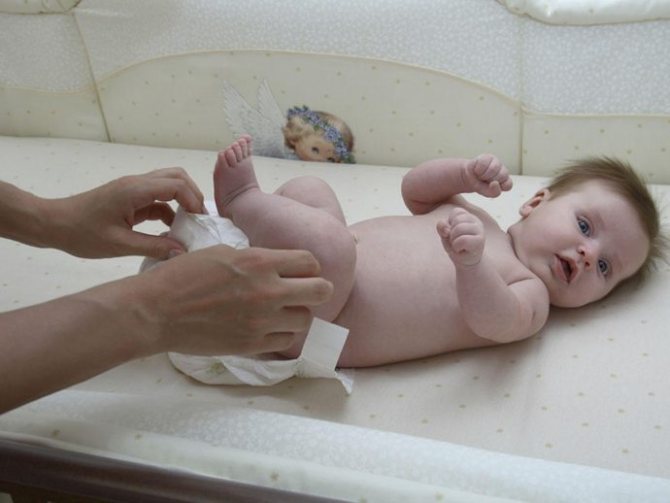
In bottle-fed babies, foamy feces often occur for the same reasons as in infants:
- Antibiotic therapy and taking various medications. Medicines, for example, for colic, can provoke pathologies in the functioning of the digestive system and the occurrence of foamy stool in a newborn.
- Early introduction of complementary foods.
- Allergy. Foamy stool may occur after changing the formula. Often this pathology occurs in a baby after drinking cow's milk.
- Intestinal dysbiosis. It is considered a fairly common occurrence. In this case, diarrhea gives way to constipation, and undigested food particles can be found in the feces. Feces have a sour odor.
- Lactase deficiency.
- Malnutrition. As a result of a deficiency of essential substances in the body, foamy and darkened stools are observed.
- Excessive gas formation.
Sometimes foamy feces can accompany a staph infection.
Diarrhea with foam, resulting from an intestinal infection, occurs with high fever, cramps, and vomiting. The child’s appetite decreases, the frequency of bowel movements increases (up to 10 times a day), and the color and consistency of feces changes.
Cause of foam in stool
- If the mother has eaten some new product, the baby’s stool becomes yellowish or even green, foam and even mucus appear in it. In this case, you need to monitor the newborn: if he becomes restless and the excrement does not become normal within 3-4 days, the mother will have to give up the new product.
- Fast feeding. It happens that the mother does not allow the baby to completely empty one breast, but immediately puts it on the other, which can also affect the color and consistency of the baby’s stool. The reason is that the newborn does not receive the so-called “hind” milk. This means the following:
- The baby receives foremilk immediately as soon as it is applied to the breast. Such food is rich in minerals and protein and has a bluish color;
- “hind” milk has a different consistency; it is thick, yellow in color, and contains a lot of fats and enzymes for breaking down lactose.
The ideal option for breastfeeding is one in which the baby receives the full volume of milk, since the “front” is absorbed less well, and the “back” is necessary for this process to take place. Undigested food is fully reflected in the quality of feces - it becomes foamy and changes color.
The most dangerous causes
The causes of foam in a baby's stool are not always safe. Sometimes the mother's concern about this problem is more than justified.
In such a situation, a visit to the doctor is required, and the mother should study the main symptoms by which she can understand that her child needs help. What can cause foam to appear in stool and harm the child’s health?
If a small child’s stool suddenly becomes watery, acquires an unpleasant odor, and foam appears in it, even though the baby begins to poop much more often than before, the cause of this problem may be lactase deficiency.
Lactase is an enzyme that helps break down lactose in the newborn's body. If there is a deficiency of this substance, undigested lactose ends up in the child’s intestines, causing the formation of foam in the stool.
Other symptoms of lactase deficiency:
- nausea;
- colic;
- constant crying and breast refusal;
- painful rumbling in the child's stomach.
In this case, the stool becomes yellowish-green, and the excrement contains a large amount of mucus.
What do we have to do? All the symptoms described above can be present in completely healthy children. It is impossible to determine lactase deficiency on your own.
It is necessary to contact a pediatrician who will diagnose, refer for tests and prescribe treatment. Most often, doctors recommend closely monitoring the baby’s feces and adding lactase to the “foremilk.” Its dose is selected according to individual indicators.
If your baby's stool has acquired a watery consistency with foam, a bright green color, and a rotten smell, these are most likely symptoms of a dangerous infectious disease. The cause of infection in the intestines is pathogenic microflora. The virus enters a child’s mouth in one of a huge number of ways and begins to act, undermining his health.

Other signs of intestinal infection:
- severe vomiting;
- increased body temperature;
- refusal to eat;
- the child twists his legs and bends them under his stomach;
- The baby screams loudly all day long.
You must call an ambulance immediately! In the case of infants, getting rid of intestinal infection is possible only in a hospital setting under the supervision of specialists.
In the hospital, all the necessary tests will be taken from the baby and a glucose drip will be placed, which will lower the temperature, eliminate the fever and improve the patient’s well-being. If the case turns out to be very severe, the doctor will prescribe antibiotics, as well as antipyretic and antiemetic drugs. The baby, who is under the supervision of specialists, is not in danger.
How to treat foamy stools in babies
When noticing that a child’s stool is foaming, what actions should his mother take? Don't panic is the main thing. After all, her nervousness is passed on to her child. You need to act consistently and competently. The best adviser in such cases will be breastfeeding specialists and children's doctors.
First of all, they will recommend getting tested. There is no need to guess what factor became the catalyst for the problem in a boy or girl. It is necessary to bring a diaper with fresh baby feces to the clinical laboratory. The test results will reveal the infection if the baby has it. Then the pediatrician will prescribe the correct, safe therapy and monitor the process. If an infection is detected, the doctor will prescribe drugs to the young patient to destroy it. These could be:
However, there may be other reasons for foam in a baby's stool. And bacterial culture will help to establish them. Such a study determines the composition of the intestinal microflora, identifies pathogenic bacteria, as well as the ratio of harmful and beneficial microorganisms. If there is a deficiency of the latter, pediatricians usually diagnose “dysbacteriosis” and prescribe special medications in the form of beneficial bacteria to young patients. Such medications may be:
- Acipol;
- Lactobacterin;
- Linux.
After a course of such drugs, the child’s stool with foam disappears, the stool returns to normal, and the child calms down. Another current recommendation is correcting nutrition, reducing single servings and reducing the time between feedings. This mode helps the baby’s ventricle more easily digest and assimilate incoming food.
Children's doctors emphasize: dehydration is the main danger of diarrhea and foamy feces. A deficiency of fluid in a child's body makes the child apathetic, weak, and lethargic. The consequences of dehydration are:
- retraction of the large fontanel;
- the appearance of rashes on the skin;
- cloudy urine;
- less frequent urination.
That is why it is important to compensate for lost fluid and supplement the child’s nutrition. Children's doctors advise doing this every 10-20 minutes. You can use the medication Regidron at the stage of identifying the cause of the problem. It is necessary to drink this liquid in a way convenient for the baby: from a spoon, from a bottle, or inject it with a syringe, having previously removed the needle.
Main causes
Foamy stools in infants can be caused by various reasons:
- non-compliance with diet by a nursing mother;
- development of intestinal infection;
- incorrect feeding regimen;
- allergic predisposition;
- lactase deficiency;
- disorders of the digestive system.
If the stool of a breastfed baby foams and becomes liquid, the reason may lie in an allergic predisposition. Together with mother's milk, the baby receives substances that can cause irritation of the digestive tract and intestines. To eliminate the problem, a woman just needs to determine which product causes her baby’s allergy and eliminate it.
Foam in the stool often appears when complementary foods are introduced incorrectly and untimely, when the baby is given foods that are not age-appropriate and irritate the baby’s delicate intestines. Infants under six months of age often experience gastrointestinal disorders after drinking cow's milk. Medicines that the mother takes or gives to the baby (even anti-bloating medications) can also trigger allergies and cause loose, foamy stools.

When breastfeeding, it is important for a woman to adhere to proper nutrition
When a baby has foamy stools and their color changes to green, you should not hesitate to visit the doctor. It is necessary to take tests for microflora disorders, infection with staphylococcus and other infectious agents.
The development of an infectious intestinal disease occurs against the background of severe symptoms:
- heat;
- nausea and vomiting;
- abdominal pain;
- increased frequency of bowel movements up to 10-20 times a day;
- lack of appetite.
Foamy stool with an admixture of foam, which has an unpleasant odor, also appears with the development of a staphylococcal infection with suppuration of wounds on the baby’s body, the growth of boils and inflammation of the mucous membranes. Therapy is selected by a pediatrician.
The appearance of foamy stools in infants is often caused by malfunctions of the digestive system. These include:
- dysbacteriosis - manifested by alternating constipation and diarrhea, foamy stool with a strong sour smell, a change in the shade of stool to too light and greenish;
- increased formation of gases - the condition can be eliminated by selecting a diet for a nursing mother, preventing bloating and colic;
- enzyme deficiency - a weakened digestive system, not ready for excessive loads, can react with foamy stools to sucrose, fructose, lactose, and the introduction of complementary foods.
As a result of malnutrition, when a baby does not receive enough formula or breast milk, a nutritional deficiency develops in his body. In such cases, the color of the stool becomes darker, and an admixture of foam appears in it.
As already mentioned, foamy stools also occur when there is an imbalance of milk from the anterior and posterior mammary chambers. When fed only with foremilk, the baby develops lactase deficiency, which is why liquefied feces with foam appear.
Causes of illness in infants
If the baby's stool has changed in consistency, color, or the child does not have bowel movements for 24 hours, this may be the result of an infection , allergy, or dysfunction of the digestive system. Foamy stools are often scary.
There may be several reasons for this:
- failure to comply with the rules for introducing complementary foods or the occurrence of an allergic reaction to complementary foods. Foamy stools may be due to a change in the nursing mother's diet. The baby’s body reacts in the same way to drinking cow’s milk;
- lack of an element in the body - lactase. It is a carbohydrate that makes up almost 100% of breast milk;
- excess of fore and lack of hind breast milk during feeding;
- lack of micronutrients in the newborn’s body;
- the list of symptoms of staphylococcal infection includes foamy stools;
- intestinal infection is characterized by liquid stool streaked with blood and foam;
- if a nursing mother is treated with drugs.
Read more about maternal nutrition
A mother who feeds her baby with breast milk is required to adhere to a number of rules from the first days of the baby’s birth, and also keep a special observation diary, which is very useful. It will help you find out which product is not tolerated by the baby’s body and provokes changes in stool and well-being.
According to the recommendations of experts, the following requirements regarding maternal nutrition during breastfeeding were formulated:
- No diets. During childbirth and breastfeeding, the body becomes deficient in nutrients, which then need to be replenished with a proper diet rich in foods.
- Eat often and in small portions. Overeating by the mother immediately affects the baby. If she does not want the child to have constipation, gas, colic, or foam in the stool, she should eat in small portions five or six times a day.
- Proper nutrition. At the beginning of breastfeeding, the mother should eat low-fat soups and broths, pureed vegetables, porridge with water, boiled or steamed lean meat. You can also eat fruits, for example, bananas and green apples, dairy products, low-fat cheeses, cottage cheese and sour cream.
- Caution. The child’s reaction to the foods his mother eats is important. After introducing a new product, you can try another one at least a week later.
- Competent approach. You should forget about everything fatty, smoked, fried and spicy. Mom can eat stewed, boiled and steamed food, which is seasoned with vegetable oil, low-fat sour cream or lemon juice.
- Liquid. Breast milk production depends on the amount of fluid you drink. A woman should drink two to three liters of liquid per day, excluding coffee and cocoa.
There are foods that should be completely excluded from the maternal menu:
- beans;
- fresh baked goods;
- any cabbage;
- black bread;
- citrus;
- red vegetables and fruits;
- smoked;
- chocolate;
- honey;
- sweet.
What can cause foaming
Let's consider the typical causes of foam in the stool depending on the age of the small patient. I would like to note that the division by age here is quite arbitrary. It is given only to show which causes are most common at a particular stage of child development. And this does not mean at all that these disorders cannot occur in children of other age groups.
Infants
Reasons associated with natural feeding. The stool of babies fed with breast milk is thinner and more frequent than that of bottle-fed babies. While the body gets used to new living conditions, in principle, this very chair can be anything. Additional risk factors are:
1. Adaptation to some products in the diet of a nursing mother . Maternal malnutrition. The appearance of foam in stool can be caused by:
- salads containing many ingredients (for example, mimosa or Olivier);
- any fast food;
- chocolate and other sweets;
- citrus;
- whole milk;
- red vegetables and fruits;
- gluten;
- yeast.
2. Introducing new foods for the baby into the mother’s diet . In this case, slight foaming is possible, and this is normal for an infant. As a rule, there is nothing wrong with this. By 4-6 months, stool is established without outside help, and is finally formed after the introduction of complementary foods.
3. The child consumes predominantly foremilk (more liquid and rich in lactose) and a lack of hindmilk (more nutritious and fatty). This happens when the baby does not have time to completely empty one breast, and the mother already offers him the other, and this happens from time to time.
To correct the situation, you just need to allow the baby to finish the milk from the breast completely so that he has time to get to the hind milk. Make this a regular practice and soon the foam in your stool will disappear.
4. Allergy to any food product or components of infant formula (for any type of feeding), as well as a reaction to complementary feeding . Individual intolerance can manifest itself in different ways. These are not necessarily skin rashes. Foamy stools as a manifestation are also quite possible. A nursing mother should carefully monitor her own diet. And, of course, monitor the reaction of the child’s gastrointestinal tract to the introduced products.
The same goes for complementary foods. Children do not develop a relationship with all products right away. Sometimes it takes time for the body to get used to it and begin to react normally to the product. For example, some children tolerate broccoli well, while others take a long time to adapt to it and suffer from gas. Everything is purely individual, so parents are required to be as sensitive as possible to this issue. By the way, early introduction of complementary foods inevitably causes stool and digestive upset; offer your baby foods from the adult table in a timely manner.
Treatment and assistance at home
Treatment of foamy stool in a breastfed baby, if it is not caused by an intestinal infection, is carried out at home and depends on the cause. First of all, it is necessary to identify provoking factors, be it an allergic predisposition, lack of lactase or nutritional imbalance. And then eliminate them together with your doctor. The following describes the algorithm of actions that are needed to stabilize the baby’s stool.
When monitoring your baby’s well-being during the period of foamy diarrhea, you must follow several rules for home treatment:
- establish breastfeeding - feed every 2-2.5 hours and give the baby the opportunity to get to the hindmilk;
- do not independently prescribe medications for your baby - what works for one child may harm another;
- visit a doctor even for preventive purposes, get tested and make sure that foamy stools are not caused by pathological reasons.
Perhaps foamy stool is caused by problems with the gastrointestinal tract; here, a consultation with a gastroenterologist is necessary. The specialist will diagnose and prescribe treatment.
The development of diarrhea with foam requires a visit to the clinic for consultation with a pediatrician. But if the baby is feeling well and there are no alarming symptoms, a visit to the doctor is not considered urgent. Indications for urgent medical attention:
- heat;
- child's refusal to eat;
- constant vomiting;
- loud crying of the baby, indicating sharp pain in the abdomen;
- lack of urination for 8-10 hours in a row;
- signs of dehydration.
Such symptoms should immediately alert parents and force them to take the child to specialists. Dehydration due to diarrhea is a dangerous condition that develops in young children in a matter of hours.
Judging by the color and consistency of the stool, you can roughly determine at home what causes the appearance of foamy stool in your baby:
- light-colored feces with a rotten smell, increased gas production, skin rash - signs of dysbacteriosis;
- green foamy stool is a symptom not only of dysbiosis, but also of intestinal infection, if it is accompanied by hyperthermia, abdominal pain and vomiting;
- yellow feces with foam - indicates improper organization of breastfeeding and requires elimination of nutritional imbalance;
- white stool - signals poor-quality bile outflow, which requires a coprogram, analysis of the biochemical composition of the blood and ultrasound of the peritoneal organs.
If a baby develops foamy, frequent stools, it must be saved from dehydration. To do this, the baby is given solutions containing electrolytes and continues breastfeeding. There are also a number of medications that will help cope with the problem:
- Regidron, Gastrolit - solutions to prevent dehydration, which are diluted with water and given to the child to drink throughout the day;
- Smectite is a drug that helps remove harmful substances and toxins from the baby’s intestines that cause loose, foamy stools;
- Enterol is a remedy that relieves dysbiosis and intestinal infections. After 3-4 days of use, the baby’s intestines will be cleared of microbial flora, and the stool will improve;
- Hilak forte - a drug in the form of drops to restore normal intestinal flora and improve the functions of the digestive system;
- Linex - capsules containing a large number of beneficial bacteria that fight the manifestations of dysbacteriosis and disorders of the gastrointestinal tract;
- Lactase Baby - a drug prescribed to children with symptoms of lactase deficiency, it promotes better breakdown of mother's milk or artificial formula.
If taking medications at home does not produce results, and the baby’s condition worsens, you should call the doctor again and get tested. Perhaps an infection was added to a simple digestive disorder.
If foamy stools are not caused by pathological reasons, the most common advice from doctors for improving stool in children is to adjust the diet of the nursing mother. She needs to exclude fatty, fried, dairy foods, and carbonated drinks. You should also avoid foods that have a laxative effect (plums, apricots, beets) and cause increased gas formation (nuts, cabbage, apples, legumes).
A nursing mother needs to breathe fresh air more often, eat vegetables and greens, but avoid overeating. Your daily diet should include lean meats, fish, soups, and cereals. During the period of treatment for foamy stools in a baby, a woman may need advice from a nutritionist.
Foamy stool in a baby: reasons
There can be many factors influencing the appearance of foamy stools in an infant. Some of them do not require medical attention and go away on their own as the baby grows, while others lead to the need to take medications. So, the main reasons for the appearance of foamy stools include the following:
Food allergies. It's no secret that not all foods are accepted equally well by a child, especially for newborn babies. Therefore, if the mother ate some forbidden product, this will inevitably affect the child’s stool. This condition is quite rare and goes away on its own if the mother stops using the irritating product.
A similar reaction can be caused by infant formula or new foods in complementary foods. Sometimes the reason for foamy stools lies in the fact that complementary foods were introduced very early or started incorrectly. However, most often such disorders are a consequence of drinking cow's milk.
Taking medications. Many women are forced to take antibacterial or other medications after childbirth. Most of them pass into breast milk and negatively affect the baby’s health, causing disturbances in the digestive system.
Medicines given to him by his parents have a similar effect on the child’s body. Even seemingly harmless remedies for colic can cause foamy stools.
Intestinal dysbiosis. This condition is characterized by stool disorders, in which constipation is constantly replaced by diarrhea, the stool acquires a foamy consistency and a sour smell, in addition, it may contain undigested pieces of food.
In newborn children, transient dysbacteriosis is isolated, which does not require medical attention and goes away after the child’s body adapts to new conditions.
Malnutrition. Systematic failure to receive a sufficient amount of mother's milk can cause a deficiency of necessary substances in the child's body. In this situation, the baby's stool becomes darker in color and has a foamy consistency.
Increased gas formation. Very often, foamy stools accompany a period of colic and increased gas production in infants. This condition does not pose a threat to the baby’s health, but it causes significant discomfort. Therefore, you need to try in every possible way to alleviate the manifestations of colic. It should be remembered that violations in the diet of a nursing mother worsen the child’s condition, so doctors do not recommend consuming cow’s milk during this period.
Intestinal infection. Even a newborn child can encounter this unpleasant disease, which causes problems with his bowel movements. In this case, foam appears with every act of defecation. In addition, there are other signs of infection - vomiting, diarrhea, fever, abdominal pain, loss of appetite, general anxiety.
Staphylococcus infection. Foamy stool in infants is often one of the signs of staphylococcal infection. But in this case, other symptoms also occur.
Enzyme deficiency. Impaired defecation may be due to a lack of enzymes in the child’s body - in particular, sucrase, isomalt, etc. This condition is rare and occurs as a result of the child consuming foods that are new to him.
How and with what to properly treat a runny nose in infants? What causes heat rash in infants? How to treat it?
Has your baby developed diaper rash? https://klubmama.ru/zdorove/detskie-bolezni/chem-vylechit-oprelosti-u-grudnichka.html Find out how and how to treat them by following the link.
Foamy stool in a breastfeeding baby
In breastfed babies, the appearance of foamy stools is usually associated with an imbalance in breast milk. It is divided into anterior and posterior. If a child is fed exclusively with fore milk, his body has a deficiency of lactase, an enzyme that is responsible for digesting the food received.
Typically, lactase deficiency is accompanied by foamy stool, bloating, gas, colic, and bowel problems and goes away by the second month. If such problems remain, you need to reconsider the child’s diet or use additional lactase.
Foamy stool in a formula-fed baby
If a bottle-fed baby's stool changes its consistency, this indicates that the formula he is receiving is not suitable for the baby.
In addition, such disorders may indicate that the child does not have enough enzymes to digest the food received, or that he does not receive enough biologically active substances.
Light foamy stool in an infant
If a child regularly has foamy, light-colored stools, dysbacteriosis can be suspected with a high degree of probability. In this case, the stool has a sour, putrid smell and other symptoms - abdominal pain, skin rashes, bloating.
Green foamy stool in infant
The appearance of greenish stool should be a reason to immediately consult a doctor.
The fact is that, in addition to dysbacteriosis, it may indicate that the baby has an intestinal infection or staphylococcus.
Yellow foamy stool in an infant
Normally, a baby's stool should have a yellowish color. If it acquires a foamy consistency, this indicates that there is an imbalance of breast milk, in which the baby does not receive sufficient hindmilk.
Foamy, watery stools in infants
Watery stool in a child also indicates that the child consumes foremilk exclusively, while he does not get the fattier and healthier hindmilk. To prevent this from happening, it is recommended to feed the baby only from one breast until he has completely emptied it.
Liquid, foamy stool in an infant
Loose stools that have a foamy consistency may be associated with the presence of dysbiosis or disturbances in the digestion of food. Also, this condition often becomes a consequence of the development of lactase deficiency.
White foamy stool in infant
The presence of white, foamy stool indicates that the child has a violation of the outflow of bile, since it is this that affects the color of the stool. To establish the disease that led to such problems, you need to take a biochemical blood test, stool test for coprogram and conduct an ultrasound examination of the abdominal organs.
How to treat?
The following recommendations are also useful:
- you need to adhere to a certain diet and breastfeed your baby correctly;
- we must not forget about the rules of caring for a baby;
- stop self-medicating! Even traditional methods are immediately discussed with a doctor;
- The doctor cannot cause fear, so any alarming sign should be discussed with him.
If the newborn's bowel movements have changed, you need to make an appointment with a pediatric specialist and undergo all the necessary tests. Whatever the reason for the occurrence of foamy stool in a baby, the task of parents is to be attentive and monitor any changes in the child’s well-being.



